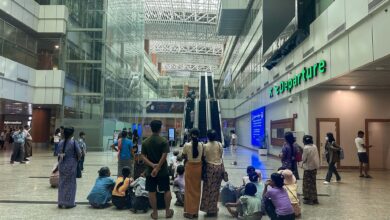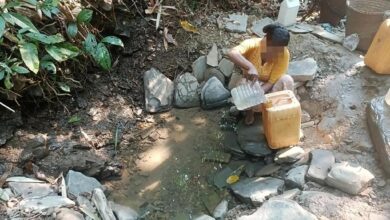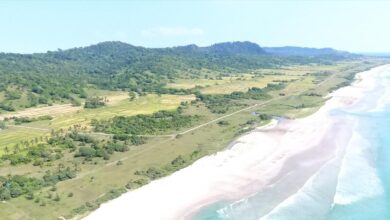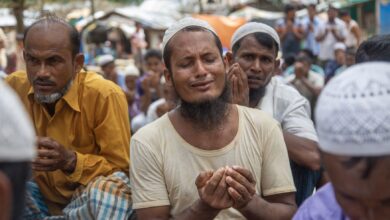
In normal times, the Thuwanna stadium in Yangon’s Thingangyun township would be teeming with cheering sports fans. At the end of 2020, however, a far more unnerving scene greets passersby.
These days, you’re more likely to hear ambulances coming and going than the rousing shouts of enthusiastic crowds. All around the stadium, red signs warn people to stay away from restricted areas.
Instead of wearing the colours of their favourite teams, those who walk in and out of a building next to the stadium stands are dressed from head to toe in white personal protective equipment (PPE).
The building is a temporary intensive care unit (ICU). And the stadium is now a 1,000-bed hospital set up to deal with the growing number of Covid-19 patients overwhelming the city’s hospitals.
Called the Ayeyarwady Centre, the facility is part of an effort by the Ministry of Health and Sports to provide care for patients caught in a second deadly wave of the disease.
“I miss my home. I want to have a home-cooked meal. But when I see these patients, I don’t want to leave. I look at them as if they were my own mother or father,” said Tun Aung Lwin, a long-term volunteer.
But dramatically increasing the number of beds available to Covid-19 patients is just part of the push to tackle this crisis head on. Just as crucial to this effort are the volunteers who help tend to patients’ needs.
One of them is 20-year-old Tun Aung Lwin, who currently works in the ICU building. After nine months on the job, he is already a veteran of the fight against Covid-19, which he joined not long after Myanmar’s first case was discovered in March.
During the first wave, which lasted from March to August, he volunteered at quarantine centres at the City Hotel, the Amara Hall at Yangon University’s Hlaing campus, and the Ywathagyi campus of the Yangon University of Economics.
As the situation stabilized and numbers fell, he took a short break from his volunteer activities. But when the pandemic started roaring back in October, he returned to work.
Speaking to Myanmar Now as he left the ICU building at the end of a shift, he said the strain on healthcare workers and volunteers was now far greater than anything he experienced earlier in the year.
“I miss my home. I want to have a home-cooked meal. But when I see these patients, I don’t want to leave. I look at them as if they were my own mother or father,” he said.
Tun Aung Lwin, who is also in charge of public relations for the student union at the Technological University (Hmawbi), is one of about 300 volunteers at the Ayeyarwady Centre, which also has around 50 doctors and nearly 200 nurses.
In the ongoing struggle to contain Covid-19, volunteers like Tun Aung Lwin have proven to be indispensable, as the country’s resources are stretched to the limit. But now, as the battle drags on, many volunteers are also reaching the point where they feel they can’t go on much longer.
Desperately needed
As of December 29, there were more than 122,000 confirmed cases of Covid-19 in Myanmar and more than 2,600 deaths from the disease, according to the Ministry of Health and Sports. At present, more than 15,000 patients are being treated at hospitals and other medical facilities across the country.
More than 1,000 cases were reported each day until December 19. Since then, the numbers have begun to drop. According to ministry statistics, the number of cases on December 28 was 648, suggesting that containment measures have begun to bring the situation under control.
The Thuwanna stadium was repurposed as a field hospital by the Ayeyarwady Foundation, a non-profit organization, in September. The transformation from an athletic to a medical facility was completed within a few days, and the hospital began treating patients in the second week of the month.

Only experienced volunteers, like Tun Aung Lwin, are allowed to work in the ICU building, where they are at greater risk of infection. Their tasks include removing bedpans, changing bedding, and cleaning patients who have soiled themselves.
Working with patients who have been completely incapacitated by the illness can be difficult even for volunteers who have dealt with milder cases.
“One patient who could not get up at all had diarrhoea. He had made a mess in his bed, and the smell was terrible. This was the first time I had to face such a situation, so I felt nauseated by it,” he said, recalling an early experience in the ICU.
Tun Aung Lwin began volunteering in March after seeing an announcement by the Yangon Region Youth Affairs Committee on his student union’s Facebook page. The committee was recruiting volunteers, so Tun Aung Lwin decided to apply.
“Some of our volunteers have left, so we always need more. I didn’t leave because I was worried that they would run out of people,” said volunteer Hayman Soe.
Now, more than nine months later, he is sharing an apartment near the Thuwanna stadium with nine other volunteers. Every morning at 8am, they take a ferry across the river that separates them from the stadium and are ready for work by 8:30.
Their first task is to feed and clean the patients. Then, the garbage has to be taken out. Because the PPP that they wear can only be used for four hours, a new shift starts at noon with a different crew of volunteers.
After spending the morning in the ICU, Tun Aung Lwin heads over to the nearby control room, where he stays until 8pm. His tasks here include transporting oxygen cylinders to wherever they’re needed, and taking out the bodies of those who have died from the coronavirus.
After a 12-hour day spent assisting doctors and nurses, he returns to his apartment in the dark, taking the same ferry that carried him across to the makeshift hospital that morning.
A spent force
Even with a declining infection rate, the end of the pandemic is still nowhere in sight. Meanwhile, the number of volunteers available to continue the fight has steadily dwindled.
While many volunteers come and go, however, a few have decided to stay in the struggle for the long haul. Among them is Hayman Soe, a 29-year-old returnee who left a hotel job in the United Arab Emirates during the first wave of the pandemic.
Since starting at the Ayeyarwady Centre in October, she has seen a steady drop in the number of volunteers, she said. When recruiting first started, 100 people would show up to volunteer. Now, however, it’s difficult to find even 20 who are willing to do what she calls the “grunt work” involved in caring for hundreds of patients.
“Some of our volunteers have left, so we always need more. I didn’t leave because I was worried that they would run out of people,” she said.
“We think it is long-term work. We need to create a situation in which volunteers can work in the long run,” said Dr Kaung Myat Soe, who is in charge of the Ayeyarwady centre
She added that as volunteers leave, the workload of those who stay behind steadily increases. This makes it even harder to quit, she said.
Meanwhile, she is worried about what will happen to her old job if she decides to stay on at the Covid-19 centre indefinitely.
“Companies are now hiring again. If I can’t go back to work when they recall me, I will lose my job. But it isn’t easy for me, because I don’t want to leave here,” she said.
But it isn’t only those who help with all the menial tasks who are at risk of burning out, said Dr Kaung Myat Soe, who is in charge of the centre. Many doctors and nurses also volunteer their time, and they are under increasing pressure, he said.
“I’m very worried that doctors, nurses and other volunteers at the centre will be exhausted,” he told Myanmar Now.

Most of the medical professionals volunteering at the centre were recruited through the Myanmar Medical Association, whose chairman, Dr Htin Aung Saw, said that nearly 1,000 doctors had volunteered for Covid-19-related activities around the country.
“As the pandemic has gone on for a long time, some doctors have returned to their regular practices, so the number of volunteer doctors is decreasing. That’s why we plan to use this force sparingly, so that those who are currently working will not be exhausted,” he said.
“We think it is long-term work. We need to create a situation in which volunteers can work in the long run,” he added.
Yi Yi Khaing, a lecturer at the Nursing School (Yangon) who went to the border town of Myawaddy in March with 30 nursing students to test migrant workers returning from Thailand for Covid-19, also expressed concern about the sustainability of current efforts to combat the disease.
“The number of health workers is low and the number of volunteers is gradually declining. We just have to try to get by with the human resources that we have,” she said.
Steering the way
On April 25, the government formed the National Volunteer Steering Committee in recognition of the role of volunteers in the fight against Covid-19.
The committee, chaired by State Counsellor Aung San Suu Kyi, is led by Dr Win Myat Aye, the minister for social welfare, relief and resettlement. It aims to train volunteers and coordinate their involvement in the emergency response to Covid-19 in line with government policy.

For some who have joined this effort, the situation remains well under control. Others, however, question how well the government has managed the crisis.
Khine Khine Swe Myint, a member of the Yangon Region Youth Affairs Committee, is one of nearly 1,000 volunteers working with “Volunteers for Covid-19 Yangon,” a local civil society organization.
She acknowledged that it has been more difficult recruiting new volunteers recently, but felt that this was not a major cause for concern.
“Having to carry corpses every day has become dispiriting work, because even as we do our best, we still see large numbers of people going around without wearing masks,” said volunteer leader Min Thwe Thit
“For the time being, we are still able to keep our work in balance here. There are a few places where we could use a few more people, but it is not an overloaded situation,” she said.
But Min Thwe Thit, a former leader of the All Burma Federation of Students’ Unions, sees the situation differently.
He started a volunteer group of his own, the Syriam Brothers Group, in Yangon region’s Thanlyin township. It focusses on transporting suspected Covid-19 patients to the hospital and taking away the bodies of those who have died from the disease.
Min Thwe Thit said that he started out with more than 40 volunteers, but now has only about half that number. Those who remain are, he said, exhausted.
And it isn’t just volunteers who are showing signs of fatigue. Donors are also more reluctant to give than they were in the early months of the pandemic, he said.
But that isn’t the real problem, he insisted. While members of the public were doing everything in their power to assist, the government was failing to do its part, he said.
“Having to carry corpses every day has become dispiriting work, because even as we do our best, we still see large numbers of people going around without wearing masks,” he said.
“That’s why we’re frustrated with the government’s approach to Covid-19.”



